Grids Search
You can use the Search function across the Profitability and Pricing modules to navigate relevant relationships, customers, pricing opportunities, account numbers, and system users.
You can begin a search from any page of the application. Enter at least three characters in the Search field, and then select Go.
You can enter alpha and/or numeric strings in the Search field. However, as a user-centric tool, Search is not designed to find every instance of numbers, rates, or character strings in the grids. The grids are not part of relationship names, instrument names, customer names, account numbers, or usernames.
If you enter a single string of three or more characters in the Search field, the application uses the wildcard character (*) automatically. For all searches, capitalization in the searched text is ignored to ensure that all possible matches are identified. You can enter any character, but certain entries or combinations of characters may not return results. If results are returned, they are ranked according to how strongly they match the complete query.
You can search two or more strings of characters simultaneously by entering the strings in the Search field. Separate each string using one of the supported Boolean operators. The most commonly used operators are OR, AND, and NOT. These operators must be capitalized in search queries.
The OR Operator
The OR operator is the default and is assumed if you do not enter another Boolean operator. A match is found if any of the strings exist in one or more information categories, such as relationship, pricing opportunity, customer name, account, or user. You can use the double pipe symbol (||) in place of the word OR.
The search process automatically performs a wildcard (*) search on the last string that you enter. If an asterisk is not added to the other strings, the search process looks for direct matches.
In the following search example, the application is searching for exact matches for Sam or Joh or names containing any variation of Tom. This search only returns Tom results.
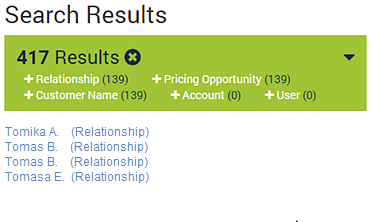
In the following search example, asterisks are added to the other strings. These asterisks tell the application to search for any names that contain some form of Sam, Joh, or Tom. This search returns results for all the names.
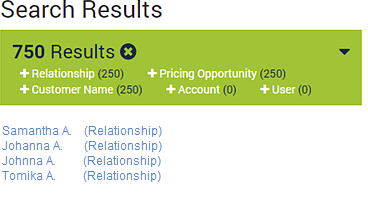
The AND Operator
The AND operator finds matches where two or more strings exist. You can use the double ampersand symbol (&&) instead of the word AND.
If the search is for names with no operators, then results for the names appear individually or together if valid results exist. You can also receive variations of some or all names.
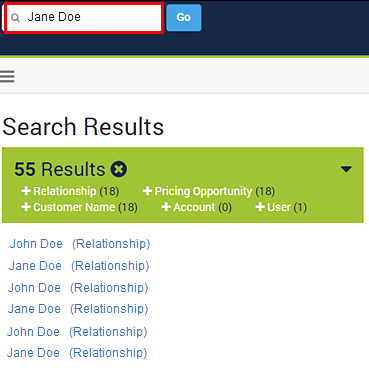
If you include the AND operator, the results only include instances of the names as they are defined in the Search field.
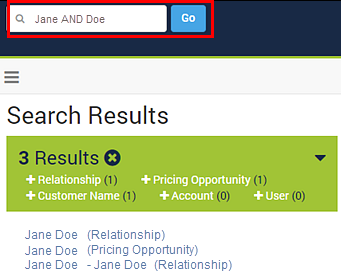
The NOT Operator
You can use the NOT operator to exclude any string that follows. You can use the exclamation mark symbol (!) instead of the word NOT.
In the following example, the application is searching for the first name but does not return any results that include the second name.
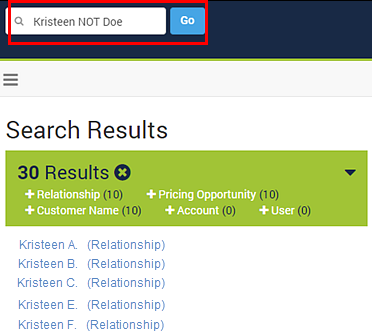
If you use the NOT operator with just one string, no results are returned.

Additional Search Techniques
You can learn about other search options, such as fuzzy searches, proximity searches, and range searches at https://lucene.apache.org/core/2_9_4/queryparsersyntax.html.
Filters
You can narrow the search results by Category using the Filters option. You can filter the search results category by relationship, pricing opportunity, customer name, account, and/or user.
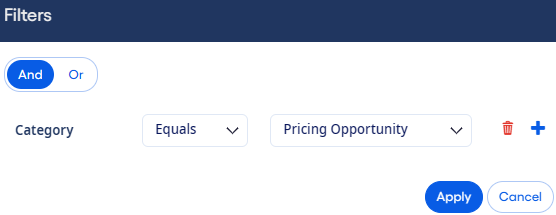
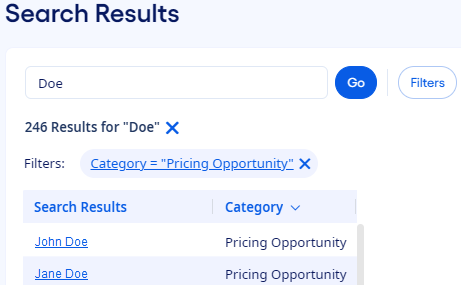
Search Result Hyperlinks
Resulting matches, each showing a name and the type of data, are provided as links on the Search Results page.
When you select a resulting link, the type of result determines where you are taken in the application.
- Relationship - To the corresponding Relationship View page.
- Pricing Opportunity - To the corresponding Pricing Opportunity page.
- Customer Name - To the corresponding Relationship View page.
- Account - To the corresponding Relationship View page.
- User - To the corresponding User Detail page.
Searching for Customers in Manage Relationships
When adding customers to relationships in Manage Relationships, the Search function provides matching data of existing customer names. This information is brought into the application through the monthly update process.